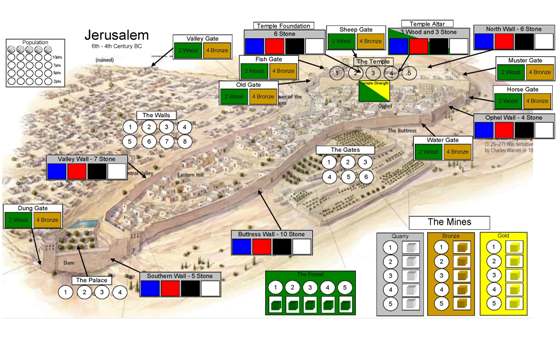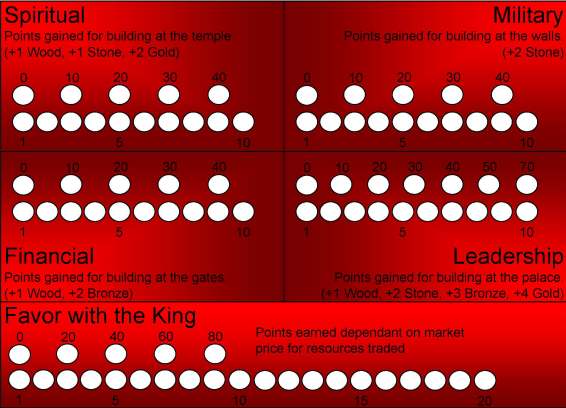March 2010 Game Design Showdown - "Back to work, Slacker!"
This Challenge has been completed.
Congratulations to the winner of this month's Game Design Showdown with 8 votes:
- "Rebuilding Jerusalem" by Piqsid (David Pontier)
Congratulations to the runner up with 6 votes:
- "Apocolypse Colony" by Glimok (Aaron Armstrong)
CRITIQUES: Post constructive critiques and commentary about the entries to this Challenge in the Critiques Thread.
Voting on the March 2010 Game Design Showdown is now closed!
- Voting: Through Thursday, 25-March-2010.
- Voting Format: Each person has 6 votes to distribute any way they choose among the GDS entries with the following restrictions:
-
- You may not assign any votes to your own entry!
-
- You may not assign more than 3 votes to any single entry.
-
- You need not assign all 6 votes.
In addition, any entry using this month's Bonus theme will receive an additional 2 votes.
Please Read: Details on entering the Game Design Showdown.
Main Design Requirements:
- Component Restriction: Multipurpose Components.
The game must include some material or materials used by the players which have multiple different possible uses. - Mechanics Restriction: Worker Placement.
The game must include a worker placement mechanism that follows these specific guidelines: -
- Each player must have exactly 4 “workers” to place
-
- There must be exactly 4 locations on the board to place workers
It's up to you to determine how the "workers" are placed, how many a player can place in a given area or how many they place at a time, and what happens if and when they've placed their workers.
- Bonus Theme: Alternate history. I liked the Bonus Theme last month, so it’s back again this month. There is no theme restriction this month, but if you attempt the Bonus theme, you get 2 extra votes. The Bonus theme this month is “Alternate history” – meaning a historical setting or theme, only not accurate – like Inglorious Bastards, where a plot to kill Hitler ended up succeeding, or The Watchmen, which took real history from the 1930s, and followed it in another direction than where it really went.
- Submissions: Thursday, 11-March-2010 through Thursday, 18-March-2010 (approximately 4pm West Coast US time).
GDS is now closed!
- CRITIQUES: Post constructive critiques and commentary about the entries to this Challenge in the Critiques Thread Comments or Questions: Comments and questions about this Challenge were handled on the Comments Thread. GDS Details: For more details on how these Game Design Showdown Challenges work, especially the details around the word count and graphics limits, visit the GDS Wiki Page. Enjoy! -Seth






Apocalypse Colony
3-6 players
The Cold War ended in nuclear disaster. What's left of civilization has been reduced to small colonies in remote areas of the world. Your colony has just been established, hoping to survive the brunt of the oncoming nuclear winter. Unfortunately, a more pressing matter has just emerged...
Start of the Game
One player plays as The Blob, a post-nuclear nightmarish goo-monster. The rest
of the players work cooperatively in the colony to defeat The Blob while keeping the colony alive.
The colony begins with 5 food per player and each non-blob player begins with 4
workers and 5 gold. Each science starts at the left track and The Blob starts with full life and 4 tentacles.
Turn Structure
Each turn, play goes as follows: -Consumption -Production -Combat -Status Report
The Consumption Phase
Each worker consumes one of the colony's food, or dies of starvation. Then, each player may pay one gold to place a worker on an unoccupied tile on the board. After players are done, The Blob then places each of its tentacles on the board on an unoccupied tile.
The Production Phase
First, each player declares any workers they have that will be assigned as soldiers as opposed to workers. For workers: The upper-left quadrant is the "farm"; each worker there produces the number of food indicated in that tile, plus any bonuses, for the colony. The upper-right quadrant is the "mine", producing gold; each worker there produces the number of gold indicated in that tile, plus any bonuses, for their respective owners. The lower-right quadrant is the "laboratory"; each worker there produces one science point toward any technology. The lower-left quadrant is the "infirmary". Each worker assigned here makes one ill worker well again. For each worker that is assigned to a building, the player draws a corresponding card. The Blob draws a corresponding card for each tentacle.
Note that The Blob can damage tiles. If a non-ill worker is on a damaged tile, that worker repairs the tile instead of getting cards and producing anything.
The Combat Phase
First, The Blob attacks the colony by rolling a 1d6 for itself and each spawn on the board, damaging 1-3 tiles of The Blob's choice. Soldiers attack The Blob via its tentacles in the same building. The player and The Blob each roll a 1d6, with the player adding bonuses. If the soldier's number is higher, subtract the blob's number from the soldier's number and the blob loses that much life (move the blob's life token down the track). If The Blob wins, subtract the soldier's total from the blob's total. If that number is 3 or greater, that soldier dies, otherwise that soldier takes ill. Soldiers may also attack Blob Spawn in the same fashion as they attack a tentacle. If the soldier wins, remove the spawn and replace each spawn space with a damaged tile.
The Status Report Phase
Players may use gold they have to play cards in hand. The cost, in gold, to use each card is shown in the card's gold circle. Players may discuss card usage and pool gold as they wish. Afterwords, The Blob plays cards. The Blob can play any cards in which it has enough tentacles that card's building, as shown in the pink circle.
Unused cards are discarded to the bottom of the piles from which they came. Cards in play are then discarded (unless stated otherwise). Play then resumes to the next Consumption phase.
Other rules
The Sciences
Science tracks go from the left to the right; move the token one tile for each science point. That science grants a bonus of [n], depending on the number that the token is on. Repair Bots: Repair [n] damaged tiles each turn. Attack Bots: Attack bots deal [n] damage to The Blob each turn. Hydroponics: Each food tile produces an additional [n] food. Medicine: At the start of the consumption phase, [n] ill workers are made well. Weaponry: Each soldier gets a +[n] bonus to their die rolls.
Ill Workers
When a worker becomes ill, that worker must go to the infirmary until made well or killed. That worker still consumes food and a tile at the infirmary, but does not require gold to work. If a tile occupied by an ill worker becomes damaged, that worker dies.
Blob Spawn
Blob Spawn occupy a 2x1 area of tiles; workers cannot be assigned to a tile occupied by blob spawn.
The End of the Game
The Game ends when either The Blob dies or all workers have died.
Images: